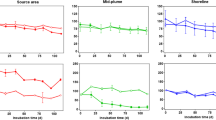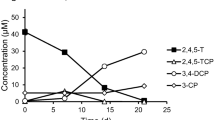Abstract
An anaerobic, Fe(III)-reducing enrichment culture, which originatedfrom a sediment sample collected at a landfill in Nanji-do, Seoul, Korea, was capable ofdegrading cis-1,2-dichloroethylene (cis-DCE) and vinylchloride (VC). Although it exhibited the ability under Fe(III)-reducing conditions, the chlorinated ethenes degradationwas not linked to the Fe(III) reduction. During cis-DCE degradation, no VC, ethene, or ethanewas detected through the experimental period. Also, this culture did not accumulate ethene andethane during the VC degradation. It was unlikely that cis-DCE was reductivelydechlorinated to VC and then the VC formed was dechlorinated fast enough. Because the kinetic datashowed that the rate of cis-DCE degradation was 3.5 times higher than that of VC. Whereasglucose supported the culture growth and the degradation, formate, acetate, butyrate, propionate,lactate, pyruvate, and yeast extract did not. The results appeared consistent with the involvement ofoxidative degradation mechanism rather than reductive dechlorination mechanism. The traits of the culturedescribed here are unusual in the anaerobic degradation of chlorinated ethenes and may be usefulfor searching an effective organism and mechanism regarding anaerobic cis-DCE and VC degradation.
Similar content being viewed by others
References
Bagley DM & Gossett JM (1990) Tetrachloroethene transformation to trichloroethene and cis-1,2-dichloroethene by sulfate-reducing enrichment cultures. Appl. Environ. Microbiol. 56: 2511–2516
Bloom Y, Aravena R, Hunkeler D, Edwards E & Frape SK (2000) Carbon isotope fractionation during microbial dechlorination of trichloroethene, cis-1,2-dichloroethene, and vinyl chloride: Implications for assessment of natural attenuation. Environ. Sci. Technol. 34: 2768–2772
Bradley PM, Chapelle FH, Lovley DR & Vroblesky (1996) Measuring rates of biodegradation in a contaminated aquifer using field and laboratory methods. Ground Water 34: 691–698
Bradley PM & Chapelle FH (1997) Kinetics of DCE and VC mineralization under methanogenic and Fe(III)-reducing conditions. Environ. Sci. Technol. 31: 2692–2696
Bradley PM & Chapelle FH (1998) Microbial mineralization of VC and DCE under different terminal electron accepting conditions. Anaerobe 4: 81–87
Bradley PM, Chapelle FH & Lovley DR (1998) Humic acids as electron acceptors for anaerobic microbial oxidation of vinyl chloride and dichloroethene. Appl. Environ. Microbiol. 64: 3102–3105
Bromfield SM (1954) The reduction of iron oxide by bacteria. J. Sci. 5: 129–139
DeBruin WP, Kotterman MJJ, Posthumus MA, Schraa G & Zehnder AJB (1992) Complete biological reductive transformation of tetrachloroethene to ethane. Appl. Environ. Microbiol. 58: 1996–2000
DiStefano TD, Gossett JM & Zinder SH (1991) Reductive degradation of high concentrations of tetrachloroethene to ethene by an anaerobic enrichment culture in the absence of methanogenesis. Appl. Environ. Microbiol. 57: 2287–2292
Duhamel M, Wehr SD, Yu L, Rizvi H, Seepersad D, Dworatzek S, Cox EE & Edwards EA (2002) Comparison of anaerobic dechlorinating enrichment cultures maintained on tetrachloroethene, trichloroethene, cis-dichloroethene and vinyl chloride. Wat. Res. 36: 4193–4202
Flynn SJ, Löffler FE & Tiedje JM (2000) Microbial community changes association with a shift from reductive degradation of PCE to reductive degradation of cis-DCE and VC. Environ. Sci. Technol. 34: 1056–1061
Froelich PN, Klinkhammer GP, Bender ML, Luedtke NA, Heath GR, Cullen D, Dauphin P, Hammond D, Hartman B, & Maynard V (1979) Early oxidation of organic matter in pelagic sediments of the eastern equatorial Atlantic: suboxic diagenesis. Geochim. Cosmochim. Acta 43: 1075–1090
Hirata T, Nakasugi O, Yoshida M & Sumi K (1992) Groundwater pollution by volatile organochlorines in Japan and related phenomena in the subsurface environment. Water Sci. Technol. 25: 9–16
Karlin R & Levi S (1983) Diagenesis of magnetic minerals in recent haemipelagic sediments. Nature 303: 327–330
Komatsu T, Momonoi K, Matsuo T & Hanaki K (1994) Biotransformation of cis-1,2-dichloroethylene to ethylene and ethane under anaerobic conditions. Water. Sci. Technol. 7: 75–84
Maym'o-Gatell X, Tandoi V, Gossett JM & Zinder SH (1995) Characterization of an H2-utilizing enrichment culture that reductively dechlorinates tetrachloroethene to vinyl chloride and ethene in the absence of methanogenesis and acetogenesis. Appl. Environ. Microbiol. 61: 3928–3933
Maymó-Gatell X, Chien Y, Gossett JM & Zinder SH (1997) Isolation of a bacterium that reductively dechlorinates tetrachloroethene to ethene. Science 276: 1568–1571
Maymó-Gatell X, Nijenhuis I & Zinder SH (2001) Reductive degradation of cis-1,2-dichloroethene and vinyl chloride by “Dehalococcoides ethenogenes”. Environ. Sci. Technol. 35: 516–521
Milde G, Nerger M & Mergler R (1998) Biological degradation of volatile chlorinated hydrocarbons in groundwater. Water Sci. Technol. 20: 67–73
Parsons F, Wood PR & DeMarco J (1984) Transformations of tetrachloroethylene and trichloroethylene in microcosms and groundwater. J. Am.Water Works Assoc. 76: 56–59
Ottow JC (1968) Evaluation of iron-reducing bacteria in soil and the physiological mechanism of iron-reduction in Aerobacter aerogenes. Z. Allg. Mikrobiol. 8: 441–443
Pfenning N, Widdel F & Trüper HG (1992) The dissimilatory sulfate-reducing bacteria. In: Balows A, Trüper HG, Dworkin M, Harder W & Schleifer KH (Eds) The prokaryotes. 2nd Vol.1 (pp 926–940). Springer Verlag, New York
Rosner BM, McCarty PL & Spormann AM (1997) In vitro studies on reductive vinyl chloride dehalogenation by an anaerobic mixed culture. Appl. Environ. Microbiol. 63: 4139–4144
Schmidt SK, Simkins S & Alexander M (1985) Models for the kinetics of biodegradation of organic compounds not supporting growth. Appl. Environ. Microbiol. 50: 323–331
Tandoi V, DiStefano TD, Bowser PA, Gossett JM & Zinder SH (1994) Reductive dehalogenation of chlorinated ethenes and halogenated ethanes by a high-rate anaerobic enrichment culture. Environ. Sci. Technol. 28: 973–979
Vogel TM & McCarty PL (1985) Biotransformation of tetrachloroethylene to trichloroethylene, dichloroethylene, vinyl chloride, and carbon dioxide under methanogenic conditions. Appl. Environ. Microbiol. 49: 1080–1083
Yang Y & McCarty PL (1998) Competition for hydrogen within a chlorinated solvent dehalogenating anaerobic mixed culture. Environ. Sci. Technol. 32: 3591–3597
Zeikus JG (1977) The biology of methanogenic bacteria. Bacteriol. Rev. 41: 514-541
Author information
Authors and Affiliations
Rights and permissions
About this article
Cite this article
Hata, J., Takamizawa, K., Miyata, N. et al. Biodegradation of cis-1,2-Dichloroethylene and Vinyl Chloride in Anaerobic Cultures Enriched from Landfill Leachate Sediment Under Fe(III)-Reducing Conditions. Biodegradation 14, 275–283 (2003). https://doi.org/10.1023/A:1024742211094
Issue Date:
DOI: https://doi.org/10.1023/A:1024742211094




